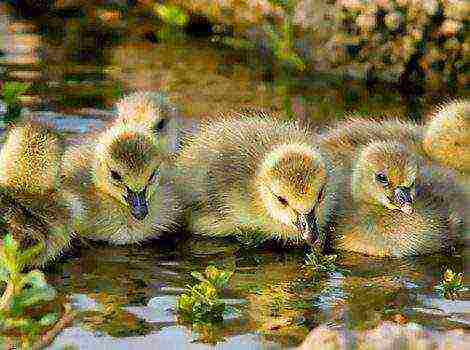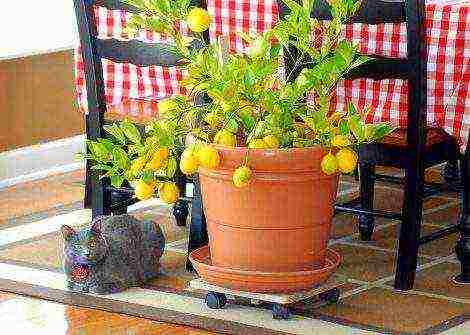Content [show]

Ripe, juicy, amazingly tasty strawberries on the table, while a blizzard is sweeping outside the window - this is a real luxury! In the middle of winter, not every supermarket can find fresh berries, and if you can find them, their cost will be prohibitively high.
Create favorable conditions for growing berries
But after all, someone grows mouth-watering strawberries at home on the windowsill, some enterprising gardeners even benefit from this activity, turning the cultivation of berries at home into a profitable business. Breeding strawberries at home - myth or reality, accessible to anyone?
Now there are various methods of how to grow strawberries in an apartment of any size. You can effectively use the free space in your home by planting strawberry seedlings in plastic bags filled with substrate, or growing bushes with berries in traditional flower pots and boxes. It all depends on the purpose for which you plan to grow strawberries at home, and how much space you can allocate for this.
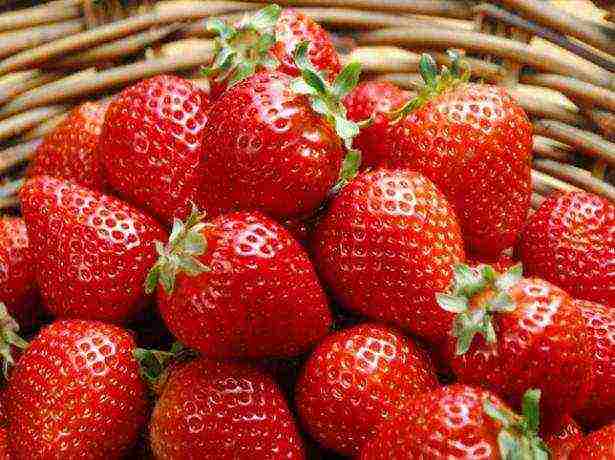
Opt for remontant strawberries that bear fruit multiple times
What do strawberries need for normal ripening? Room temperature, good ventilation and suitable soil. These conditions are easy to fulfill, because the apartments are warm at any time of the year (and if there are problems with heating, you can always buy an additional heating device), air circulation can be provided using a window, a special inexpensive substrate can be purchased in the store. This means that you can also start growing strawberries at home, if you take into account the most important points:
- Opt for remontant strawberries that bear fruit multiple times. The most popular varieties: Yellow Miracle, Queen Elizabeth, Mount Everest.
- When growing strawberries from seeds, purchased seeds should be placed in the refrigerator for 4 weeks, wrapped in a damp cloth and placed in a plastic bag - then the hardened seeds, when planted in the ground, will give friendly shoots within a week.
- Prepare a spacious pot with a good drainage layer for seedlings, as strawberries like frequent, abundant watering, but they cannot tolerate stagnant water.
- It is recommended to plant strawberry seedlings at home in prepared soil either in the fall from August 15 to September 20, or in early spring.
- Since this berry is afraid of the cold, do not keep it on the balcony, and protect it from frost.
- From time to time, do potassium-phosphorus fertilizing, and to form the ovaries, treat the plants with a special preparation "Ovary".

Ideal for growing homemade strawberries - southern, well-lit windows
The ideal option for growing homemade strawberries is the southern, well-lit windows. If there is a lack of sunlight, plant growth may slow down and the taste of the berries will deteriorate. However, you can create artificial lighting for your strawberry plantation using fluorescent lamps. Strawberries will begin to bloom and bear fruit earlier with a long daylight hours, and the quality of the berries will increase significantly. Therefore, if you are concerned about how to grow strawberries at home in the shortest possible time, provide the plants with a continuous day of light for about 14 hours.
Video about strawberries in January
How to pollinate strawberries at home?
Since strawberries at home are devoid of natural pollination, you will have to provide plants with artificial pollination during the flowering period, which can last several weeks. To produce artificial pollination flower stalks on strawberries at home, you can in two ways:
- direct a fan in the morning towards the peduncles (under the influence of the wind, strawberries are pollinated in the open field);
- pollinate each flower by hand, brushing it daily with a soft paint brush.
As you can see, growing strawberries at home is affordable even for inexperienced gardeners and does not require significant financial costs. Difficulties can arise only with pollination, especially if you decide to breed extensive berry plantations, because it is not so easy to brush every small flower every day, and with a fan, successful pollination is difficult to guarantee.
Video on how to get strawberries in January
However, you shouldn't give up! Try, plant seedlings, take good care of them - strawberries at home can bring several harvests a year, delighting you and your loved ones with ripe berries in late autumn and frosty winter.
Rate the article:
(2 votes, average: 5 out of 5)
Growing strawberries in the winter at home is easy enough. The main disadvantage of this method is the small amount of harvest. The essence of the method is that strawberries are planted as a houseplant.
Basic rules for growing strawberries in winter
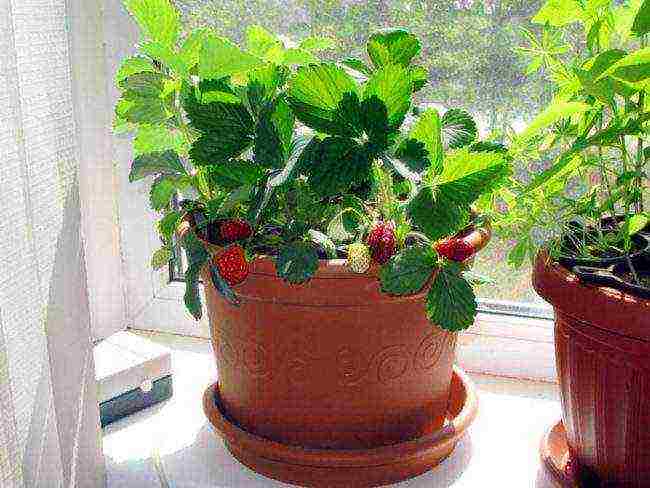
Full development and fruiting of strawberries is impossible without lighting for 12-14 hours.
The main condition for planting is to provide warmth and sufficient illumination. Availability fourteen hour daylight hours strictly required.
Fruiting occurs in June and the first half of July, when the temperature fluctuates between 22-27 degrees... This should be taken into account when growing strawberries at home.
Planting methods
You can grow strawberries in the following ways:
- Packaged.
- Potted.
- Boxed.
If the crop is planted for sale, the latter method should be used. This will require several spacious drawers. They can be replaced with bags made of polyethylene.
A significant disadvantage of this method is that they take up a large amount of apartment space. This method cannot be used in a small apartment.
If the berry is planted for yourself, then it is recommended to use flower pots. It will not work to achieve high yields. The main advantage of this method is easy care.
Air and temperature
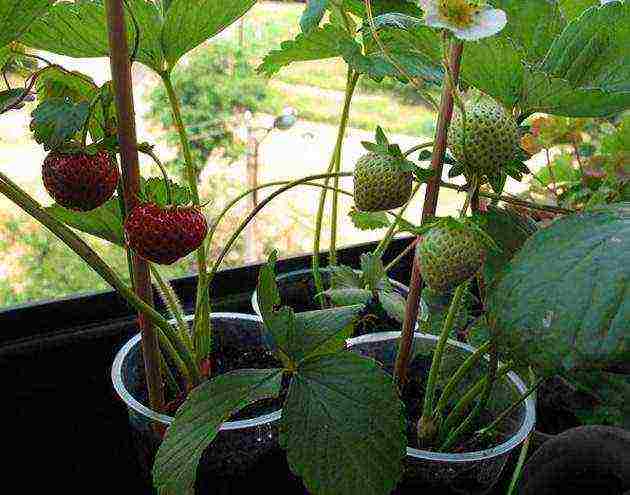
To circulate air around the strawberries, it is enough to periodically open the window.
This culture needs good air circulation... It is possible to provide her with access to air by opening a window in a vent mode from time to time.
The air temperature in the apartment in winter varies between 18-20 degrees.
This temperature is good for growing strawberries.If it rises, you can open the window to allow air circulation for the plant.
What soil to choose
The best option is to use a mixture of perlite and peat.
This soil is sold in specialized boutiques. It can be replaced with a fertilizer mixture. But its quality is noticeably inferior to the previous mixture.
Ready seedlings
You can buy ready-made seedlings; working with them does not require much time. The main disadvantage is that it will be more expensive.
Self-planting from seeds is a rather tedious method, but it does not require special monetary "infusions".
Which variety to choose for growing at home
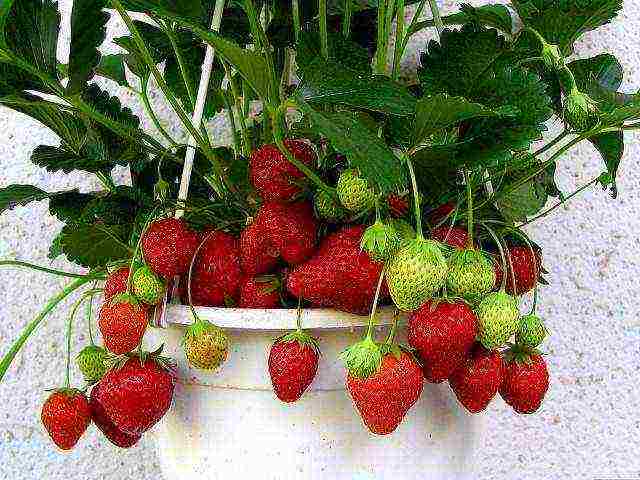
You can grow any strawberries at home, but repair varieties will give the best result.
Homemade strawberries are conventionally subdivided into ampel and bush... Fruiting can be one-time or remontant. In the second case, the culture will delight with fruits throughout the year.
The fruits of the remontant varieties differ in shape, color and taste.
For growing at home, it is recommended to opt for remontant varieties. They are less dependent on light.
The following varieties are best suited for growing in an apartment:
- Queen Elizabeth;
- Homemade delicacy;
- Geneva.
A brief overview of the most suitable strawberry varieties for growing at home.
Shrub or ampelous variety?
Between bush and ampel varieties, it is best to make a choice in favor of the latter. No bright lighting required. The first berries appear already 2 months later.
Preparatory work and soil selection
It is advisable to purchase the substrate in a specialized boutique. The choice should be made in favor of a universal soil suitable for planting vegetables and fruits.

You can make your own formula if you want.
If possible, you can prepare the soil yourself. To do this, you will need to mix:
- Sand.
- Forest soil.
- Humus.
The main criterion for the soil is looseness and moisture. Not only the condition of the seedlings depends on this, but also the yield of strawberries.
Peculiarities
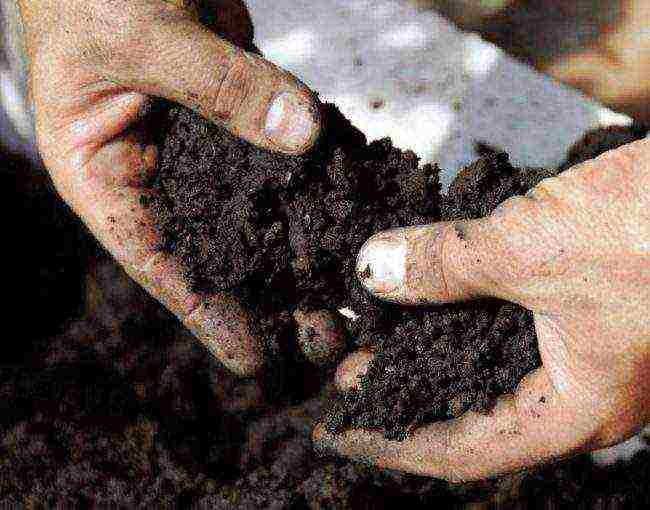
To grow healthy strawberries, the soil must be steamed or calcined.
- Covering the substrate with a crust is unacceptable... Otherwise, air access to the root system will be blocked.
- You can not take soil from vegetable gardensas it can be affected by a nematode. But if you have to work with just such a land, you need to carefully cultivate it.
- The soil needs careful steaming... This contributes to the death of all parasites. Then you need to shed the soil with a solution of potassium permanganate.
Flower planting
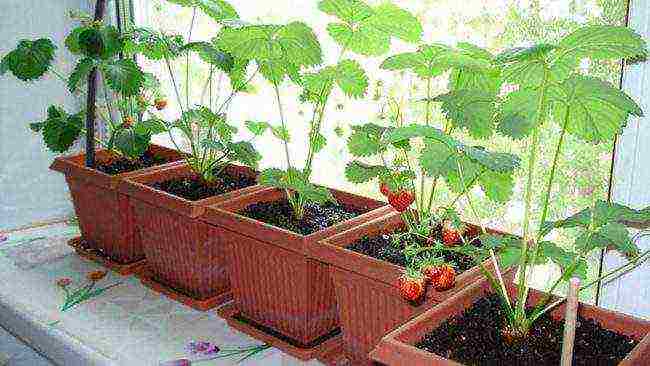
Pots of any shape are suitable for strawberries, the main thing is that the dimensions are not less than 100x150 mm.
This method requires the following elements:
- A pot with a diameter of 10 centimeters and a height of 15 centimeters.
- Prepared soil.
- Vitamin complex.
- Small pebbles of lime.
- Scoop.
- Water.
Landing
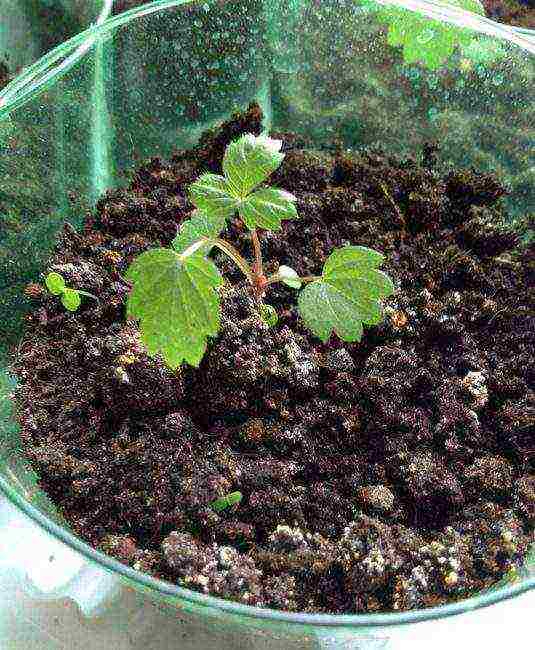
Seedlings with three or more leaves can be planted in separate pots.
- Pour pebbles into a flower pot, then soil.
- Make a well for seedlings.
- Stick the seedling into the soil, sprinkle with earth.
Watering and care
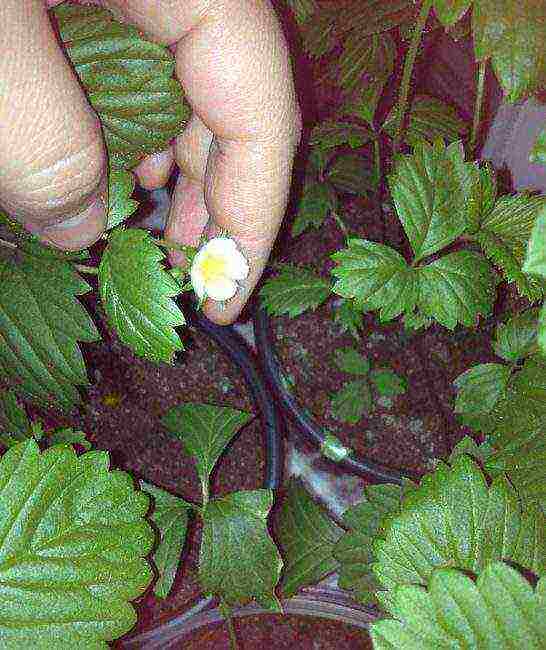
After 1.5 months, the first buds should appear.
- Water the plant as it dries.
- The strawberry pot should be on the window.
- Access to light should be maximized.
Drafts must not be allowed.
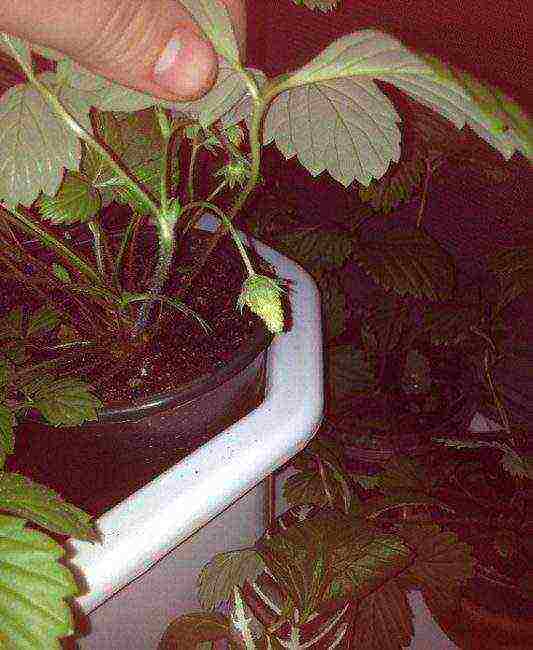
With good care, the first berries will soon appear.
Yield
Small. From 1 bush you can get up to 200 grams.
The main advantage of this method is year-round fruiting.
Planting with a polyethylene method
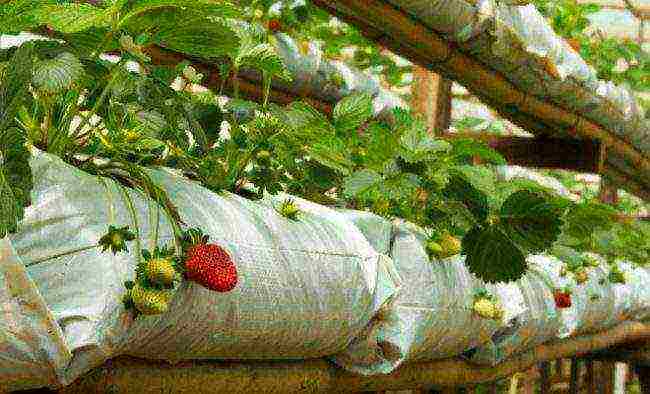
When choosing this method of planting strawberries, you should consider irrigation systems using drip pipes.
You can plant culture on a loggia or balcony. It is best to use the Dutch planting method. It may require the following:
- Suitable container made of polyethylene.
- Perlite composition + steamed peat.
- Organic soil.
- Synthetic elements.
- Watering can.
- Scoop.
It is best to use a soil substitute.

It is better to use a mixture based on perlite or vermiculite for filling the bags.
Training
Taken polyethylene with a diameter of 20 centimeters... Holes are cut in it in a checkerboard pattern.
Landing
- The distance between the bushes is up to 35 centimeters. You should not plant the bushes closer, otherwise the fruits will be small.
- The bags are filled with soil, vitamins are added.
- The angular rate of planting bushes is 50%.
Watering
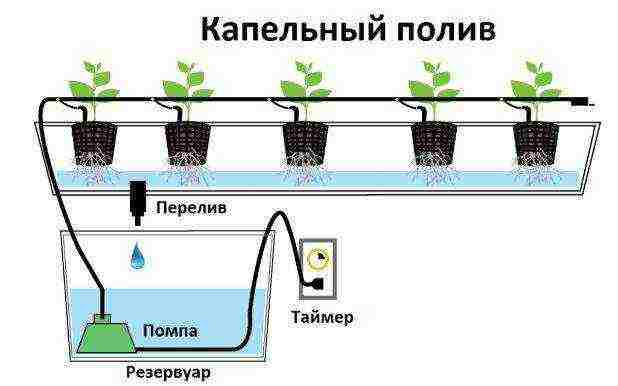
To maintain optimal soil moisture, it is better to use drip irrigation.
The culture is irrigated as it dries. It is very important to monitor the moisture of the root system.
Water should not get on the strawberry flowers.
Care
Making an irrigation system at home is quite simple. To do this, you need to use a container with a hose. The diameter of the hose should be 1 centimeter.
Such a hose must be brought to each bush and water the crop.
Lighting
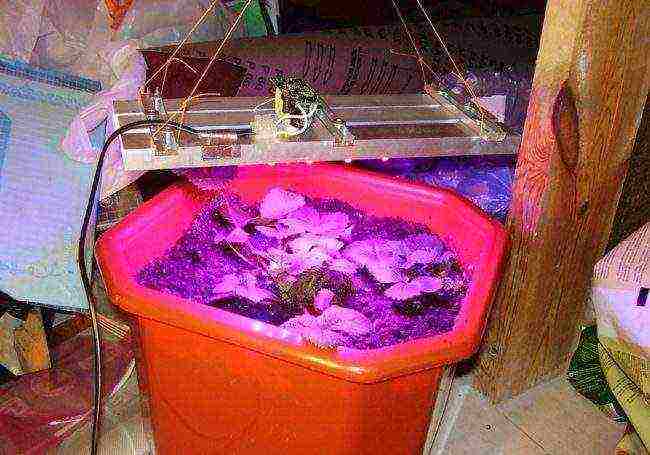
For additional lighting, homemade lamps are used.
If there is not enough light for the plant, lamps can be used. If the house has a heater, the growing process will only accelerate.
It is necessary to pollinate the culture in the process of fruit formation.
Pollination
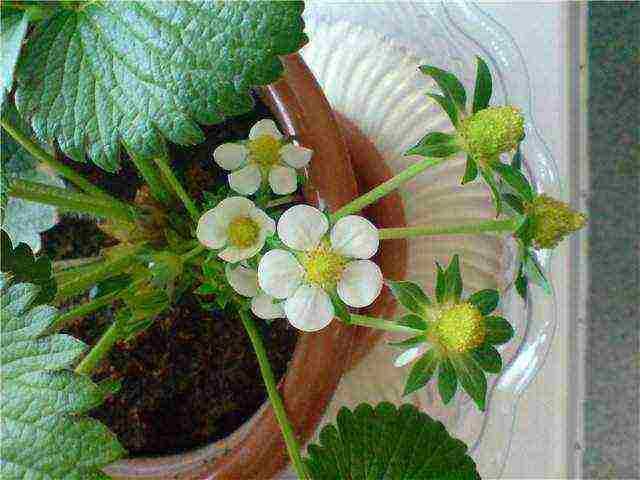
For pollination, use a soft brush or fan.
This can be done either manually or with a fan.... In the second case, the jet is simply directed towards the pots. It is advisable to do this in the morning.
For the first method, you will need a soft paint brush. This is a rather painstaking process that takes time. But its effectiveness is very high.
Feeding strawberries

For feeding, it is convenient to use instant complex fertilizers.
Replenishment of bushes should be carried out at least 2 times / 30 days... For replenishment, special fertilizers are used, which are sold in specialized boutiques. It is advisable to use a universal top dressing.
Overfeeding should not be allowed. Otherwise, all the vitamins will receive the leaves, and the berries will not ripen.
Mustache care
In the process of active growth of strawberries, tendrils are formed. They need to be tied up. To do this, a nylon mesh should be built on the window.
With the help of antennae, you can propagate the culture and get new seedlings.
To propagate strawberries, you need to root the outlet. Then it is separated from the uterine bush.
Treatment of diseases
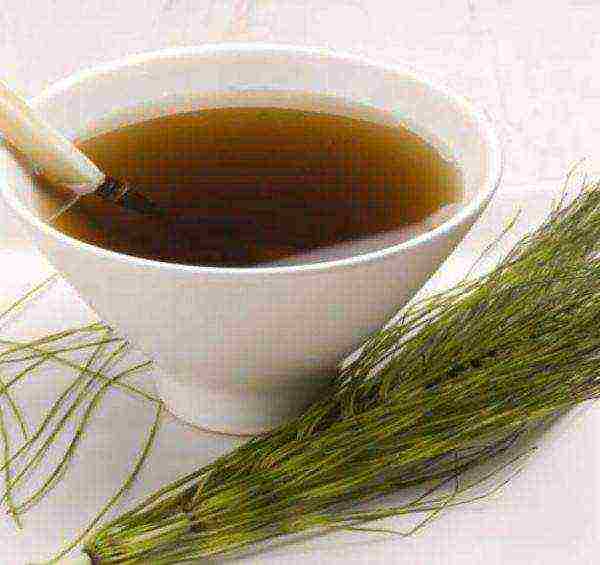
Horsetail infusion is well suited for the prevention of strawberry diseases.
The most common pathologies of domestic strawberries are gray rot and spider mites.
Fruits and leaves are affected by a specific bloom. The leaves fall off, the berry becomes loose, tasteless.
To get rid of diseases, you need to prepare a garlic solution. This requires:
- peel 2 cloves;
- crush them in a garlic press;
- pour boiling water over, leave for 20-30 minutes.
After cooling, the infusion is filtered and used when spraying plants.
Conclusion
You need to plant strawberries either in early spring or in the second half of August - September. With the right approach, it will delight you with its fruits for a long time.
Video about artificial pollination of homemade strawberries
We are looking forward to the onset of May to feast on the most delicious, perhaps, berry -
strawberries
... It has already become customary for us to receive harvests from spring to late autumn, but sometimes we really want to taste the sweetness of our favorite berry on a cold winter day!
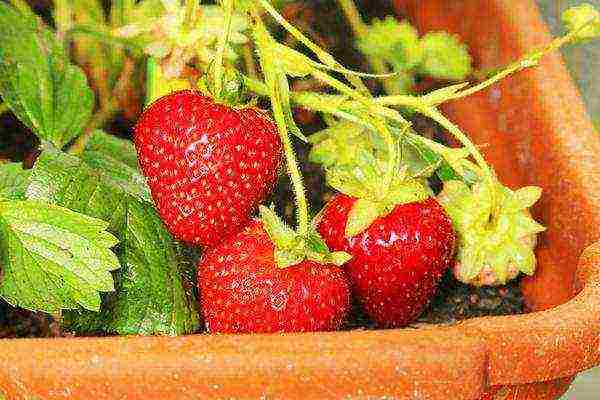
How to grow garden strawberries at home Alternatively, you can, of course, purchase a pack of strawberries for the price of gold in a supermarket. But the doubts that this berry will be useful are very large - the thought of the presence of chemistry that our body does not need at all leaves less doubt. I suggest another option: grow garden strawberries by the window and give yourself and your children a piece of summer in the middle of winter.
Is it possible to harvest garden strawberries in the room?
In this case, I really like the saying, which I am often grateful to in my life: "If you really want to, you can fly into space." So with a strong desire, guided by these recommendations, you can get wonderful sweet berries at any time of the year.
This requires:
- high-quality live (not frigo!) seedlings of varieties of neutral daylight hours (hereinafter NSD), which we get from the first row of whiskers;
- lamps (better phytolamps) for supplementary lighting of plants;
- place on the windowsill;
- This article.
How to “move” strawberries from the garden to the house?
In any case, the preparation of seedlings for home cultivation should be done long before the onset of winter.
Option 1
- When the strawberry bushes form a mustache, fill a container with a drainage hole (for example, a disposable glass or a soft plastic pot) with earth and sand in a 1: 1 ratio.
- We dig it in level with the ground (but so that the edges of the container rise slightly), direct the first outlet into the container, pin it with an ordinary hairpin or wire bent in the form of a hairpin, and water it constantly. The earth should never dry up, otherwise the plant will quickly die.
- After 3 weeks, when the young plant has taken root, we cut it off from the mother liquor and continue to water. At this point, watering is even more important; he should be at least once a day, it is better in the evening, and on hot sunny days you can water it 2 times - in the morning and in the evening.
- As soon as buds are formed on the plant, they must remove so that the outlet gains maximum strength.
- Cups with seedlings we we leave in the ground until the onset of the first frost, and as soon as it froze, we take them out of the ground, fill the resulting holes with earth and slightly compact them.
- We completely immerse the containers with plants in a slightly pink solution of potassium permanganate for 20 minutes, let the water drain, and bring them into a room with a temperature not higher than + 10 ° C for 2-3 days. Then we bring the sockets into the room and put to the south window.
- Additional lighting is required, since the length of the day is too short. The plant will need additional lighting from 6-7 in the morning until 19-20 in the evening, that is, the daylight hours for the plant should be 13-14 hours. For this we use a phytolamp.
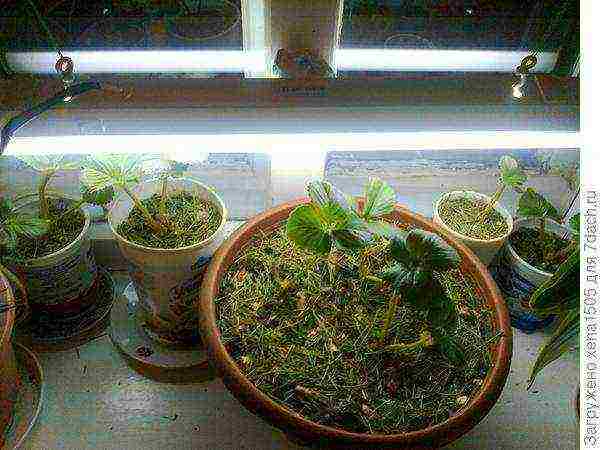
Backlight
Option 2
This method is much simpler and less laborious.
1. Before the onset of frost, we dig out rooted young rosettes, remove substandard foliage (that is, leaves that are mechanically damaged, old ones), but so that the plant must have 2-3 true young leaves.
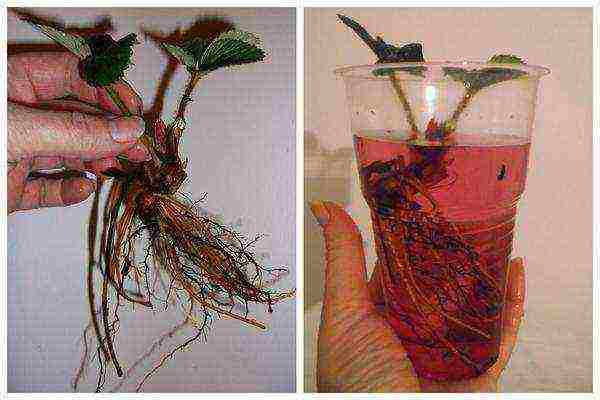
Left: garden strawberry seedling. Right: aging in potassium permanganate 2. Next, we keep the seedling in a slightly pink solution of potassium permanganate (potassium permanganate) and plant in a container with ready-made soil mixture purchased at a flower shop and mixed with sand in a ratio of 2: 1.
Why a purchased soil mixture? This is more reliable: the garden soil must be heated in the oven to destroy pests and pathogens, and the finished soil is sterile (of course, if we talk about high-quality purchased soil).
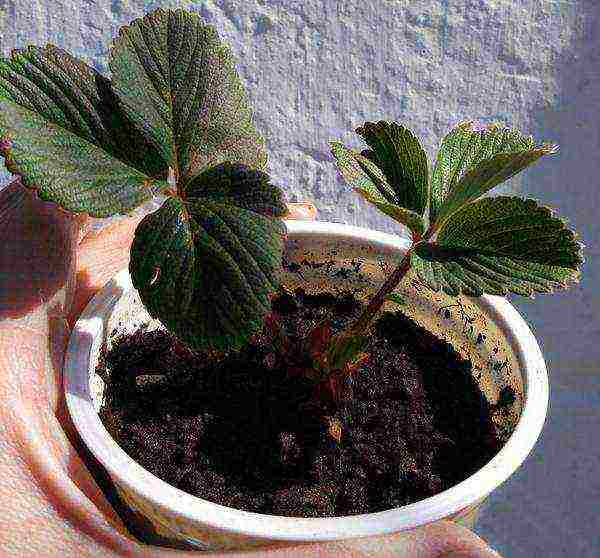
Planting strawberries 3. It is very important when planting not to deepen the heart (apical bud), which is located in the center of the rosette, otherwise the plant will simply rot.
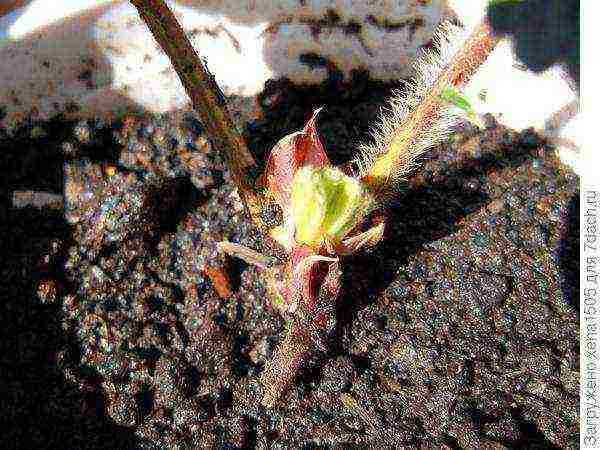
Heart 4. Water the seedlings and bring them into the room, but for the first few days do not put them on the sunny south window, but set them in more benign conditions (north, east). After 3-5 days, we rearrange it to the south. Just as in option 1, we must use additional lighting.
Which strawberry varieties are suitable for home growing?
Experimental practice, which I described earlier in my article, has shown that the NSD ‘Albion’ and ‘Aisha’ varieties are the easiest to care for and the most resistant to diseases in indoor conditions.

The ‘Albion’ variety I have told more about these and other varieties of garden strawberries in this article.
What conditions need to be created for plants to grow and bear fruit at home?
1. Lighting
As I already said, we need a phytolamp for daily supplementary lighting for 13-14 hours a day. If we neglect this point, then a well leafy plant will grow, but in this case we will not see flowering (and harvest).
Why phytolamp? You can, of course, supplement the illumination with an ordinary fluorescent lamp, but the plants in this case will be weaker. Article Choosing a phytolamp for seedlings
2. Temperature conditions
The temperature on the windowsill should be at least + 20 ° С. It is on the windowsillrather than in the room. If the temperature is not observed, then our plants can weaken and get sick with fungal diseases.
3. Watering
It is important to choose the watering mode so that so that the earthy ball does not dry out, but in any case do not allow stagnation of water.
4. Mandatory transshipment of plants
In 25-30 days after "relocation" to the house, the plants need to be transplanted into a large container (1 liter in volume), since the root system has already developed greatly, and the outlet has become cramped in a small glass. This is what the plant looks like before transplanting:
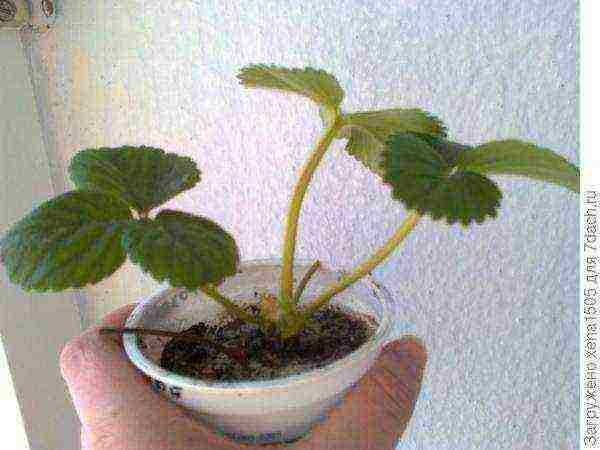
... and so - after:
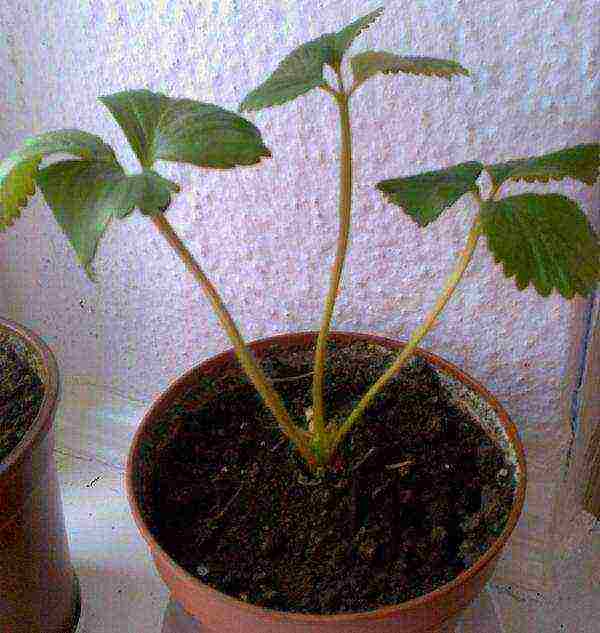
Plant transplanted into a large container
5. Artificial pollination of flowers
Pollination is an important condition for the formation of the ovary and the development of a full-fledged berry. We make it by hand using an ordinary soft brush.
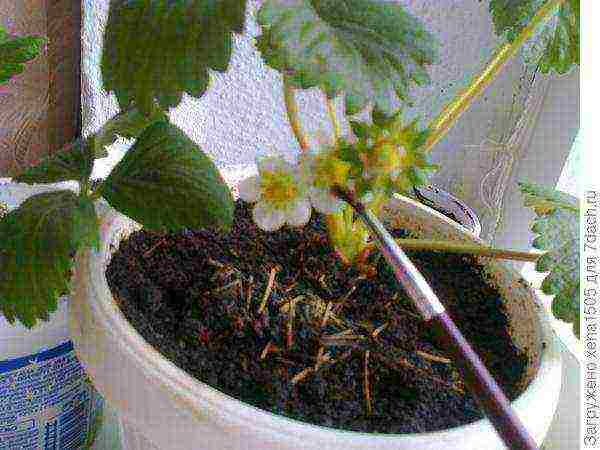
Pollination If this procedure is neglected or not performed well enough, we will get deformed berries:
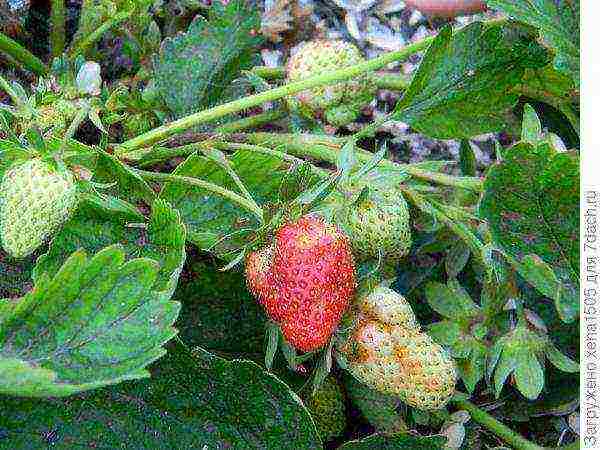
Deformation of the berry with insufficient pollination
Do you need feeding strawberries?
Like any plant, garden strawberries need nutrition. Under natural conditions, plants receive it from the ground in which plant residues have rotted. In a room, in a limited amount of soil, strawberries do not have such an opportunity, therefore, feeding should be taken care of without fail.
- We apply the first top dressing ("Strawberry" or other complex fertilizer for garden strawberries) at half dose (100 grams of solution during watering), when did the first buds appear.
- We carry out the next feeding after the first berries have been removed, with the same fertilizer at the same dosage.
Do not be embarrassed and worried that the berry will accumulate nitrates or other harmful elements, since this fertilizer will go to the plant itself, and not to the berry.
When to expect the first harvest?
Experience shows that in winter in indoor conditions the period from planting to flowering is 30-35 days, and the first berries ripen in 30-35 days from the beginning of flowering. It turns out that from the moment of planting to the ripening of the berries, an average of about 65 days pass.
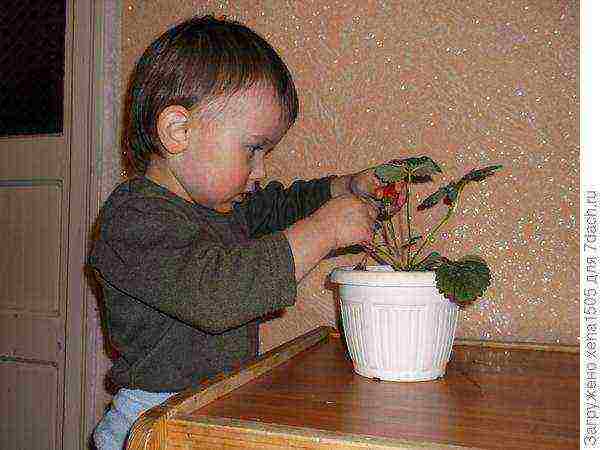
First harvest Here are our first berries:
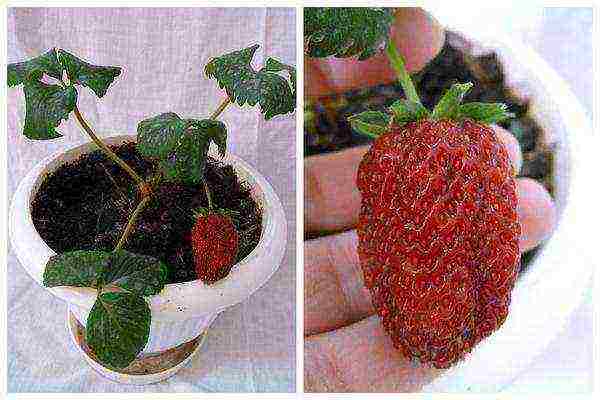
Home harvest of ‘Albion’ strawberries
What is indoor strawberry sick with and how to treat it?
If we adhered to all the recommended planting rules, and the houseplants in the house are not affected by pests, then the strawberries are not in danger of suffering from them. But besides pests, there are no less dangerous fungal diseases - such as powdery mildew, for example.
Why might problems arise? The air in the room during the heating period is dry and warm, and we, knowing that it is unhealthy, begin to increase the humidity. This is correct for us, but for garden strawberries, which are not blown by the wind at home, but is under the influence of cold from window glass, high humidity can cause powdery mildew. This is a white fungal bloom on the leaves, stems, and then the berry.
For the prevention of the disease, you can use the drug Fitosporin, which is safe for humans. We spray the plants with it once a week. Of course, white traces form on the leaves, but the plant will be reliably protected.

Garden strawberries It is not difficult to grow garden strawberries on the window, the main thing is to want very much! Good luck and excellent harvests!

Table of contents:
- Technology used for growing strawberries all year round
- Correct selection of strawberry seedlings
- List of strawberry varieties for cultivation in a greenhouse
- The cold method of storing seedlings is the basis of a full-fledged harvest
- Equipment of premises, preparation of plants for planting
- Growing strawberries vertically
- Breeding strawberries using a drip irrigation system
- Formation of mother plantation and strawberry crop rotation
- Growing strawberries at home
The beauty of garden strawberries depends on the introduction of biological technologies that create all the conditions for the cultivation of healthy, environmentally friendly berries all year round. How to grow strawberries all year round? The question is very relevant for industrial and amateur gardening. Thanks to biological products and new biotechnologies, you can get healthy, environmentally friendly berries. What is the difference between the experience of growing berries throughout the year from the technology familiar to gardeners?
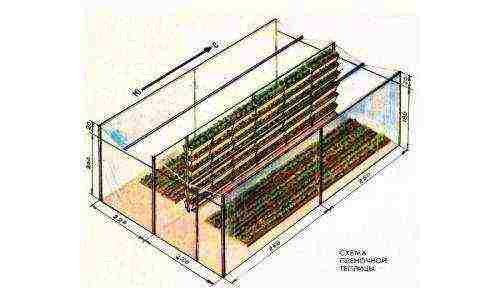
Scheme of a film greenhouse (greenhouse) for strawberries.
Any gardener can easily master the techniques for growing wonderful berries at home. It is not necessary to have a greenhouse or a heated greenhouse to work successfully. Real profit can be gained by learning how to grow strawberries all year round in an ordinary flowerpot on the windowsill.
Growing strawberries is a very lucrative home business. The profitability of such economic activity is 100%.
Technology used for growing strawberries all year round 
Diagram of vertical cultivation of strawberries.
To grow strawberries at home, Dutch technology is used, used by gardeners and large farms. The method is simple, and with proper care, about 150 kg of fresh berries are obtained from one bush.
The technique ensures the cultivation of berries all year round. There is no need to use soil, fertilizers, machinery, special equipment. There is no crop pest control. The demand for the products is very high; the product will grow environmentally friendly, free of chemicals. It is also important that, having mastered this technique, the owner becomes the owner of super-profit.
Back to the table of contents
Correct selection of strawberry seedlings
For propagation of garden strawberries, you can purchase ready-made seedlings or grow them yourself from seeds.
Seeds are subject to long-term storage. They are taken from the middle part of ripe berries. Cut off one layer, place on paper and dry. Before the time of planting, they are placed in an environment with a low temperature of + 2 + 4 ° C. Then moisten and mix.
To prepare planting material, you can grow seedlings yourself from seeds or choose a ready-made material.
There are several ways to harvest seedlings. To grow strawberries, young rosettes are cultivated on uterine plantations. Rooted whiskers are dug up in the fall on the main plantations. Seedlings are stored at temperatures from 0 to 2 ° C.
Most often, cassette seedlings are used for growing. She has a well-formed root system. Receive it after 35 days. The finished cooled outlets are placed in plastic containers. After 3 days, the length of the roots will be 3-4 cm, on the 10th day, the root system is formed. After 5 weeks, the cell is completely filled with roots.
Back to the table of contents
List of strawberry varieties for cultivation in a greenhouse 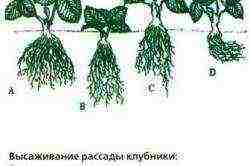
Planting scheme for strawberry seedlings.
Starting his highly profitable business, the gardener selects strawberry varieties that have a neutral daylight hours. To grow strawberries all year round, choose the strawberry variety in which inflorescences, ovaries and berries are continuously formed. The ovary is formed with a long daylight hours.Longline cultivation involves the use of varieties "Pineapple", "Brighton", "Elizabeth" and others. In practice, the varieties "Selva", "Elizabeth II" yield crops throughout the year.
Strawberry varieties are divided according to their purpose: for indoor and outdoor soil. Indoor cultivars require uniform air temperature, constant humidity and light. The crop ripens all year round. In June, the first berries are obtained: the fruits are large, resistant to powdery mildew, wilt.
Back to the table of contents
The cold method of storing seedlings is the basis of a full harvest
Growing a full harvest of garden strawberries involves the use of seedlings stored in a refrigerator or cellar. It is prepared for long-term storage in advance. They stop the growth of bushes by stopping watering them. The plant is constantly monitored: after 10-15 days, it is watered again, it is not allowed to overgrow. In the fall, the rosettes are dug out, sorted, and stored. The thickness of the root collar of the seedlings should be 6 mm, the rosettes have 3-4 leaves, the length of the roots is 5 cm.
Bunches of seedlings are placed in boxes, put them in a cellar. It has a shelf life of 1.5 to 10 months. Plant it as needed. Storage temperature +6 + 2 ° С, humidity - 90%, СО₂ content - 5%, oxygen - 2.5%. A sharp change in the microclimate must not be allowed.
Back to the table of contents
Equipment of premises, preparation of plants for planting 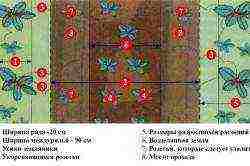
Strawberry planting schemes.
The room for growing berries is prepared in advance. It can be a non-residential room, garage, shed. It is necessary to prepare bags of strawberry seedlings. They are installed vertically along the entire room. In the row spacing, the distance is 90 cm, between the bags - 15-30 cm. In the first and second rows, the bags are slightly displaced in relation to each other. Density of distribution of bags - 2-3 per 1m².
Procured:
- container for supplying solution;
- adapter;
- plastic pipe;
- nozzles;
- clamps-clamps;
- fluorescent lamps;
- metal corners;
- foil;
- dropper tubes;
- bag.
The container for the nutrient solution is attached to the bracket. Using adapters, branching is created for the pipeline. Clamps are attached to it, which support the bag in an upright state. Strawberry bags can be placed in 2 tiers with a distance of 30 cm between them. Install the lighting system by mounting fluorescent lamps. To grow strawberries all year round, lamps must illuminate the entire planting area. Foil is placed on the walls, which serves as a reflector.
Back to the table of contents
Growing strawberries vertically
Strawberry variety table.
Growing strawberries vertically allows you to get a large harvest of berries. Vertical planting is done to save space, collecting environmentally friendly berries.
To equip a vertical bed for strawberries, you will need the following tools:
- bit;
- drill;
- plastic pipe;
- stub;
- leg-split;
- sackcloth.
The required pipe length is measured. Holes are drilled at the top. The pipe is covered with burlap, covered with twine. In the larger pipe, 3-4 holes are drilled in each row. A total of 4 rows are formed. A plug is placed on the lower hole. The workpiece is attached to a fence or mesh. A narrow pipe is placed in the main pipe and covered with a 10 cm thick layer of gravel.
Strawberries are planted in the windows on the main pipe. A second landing option is possible - through the pyramids. To create them, you need a similar set of tools. Space-saving design. They take 3-4 old tires, in each they make a hole with a diameter of 10-20 cm. Lay them in a heap in the form of a pyramid, cover it with soil. Before planting, the soil is fertilized with humus.
Back to the table of contents
Growing strawberries using a drip irrigation system
To grow berries you need to prepare:
- droppers for solution;
- opaque film;
- pallet;
- plastic bags;
- water pumps;
- tank;
- nutrient solution.
The strawberries are placed on the substrate. Using droppers, they adjust the supply of the nutrient mixture to the root part of the plants. The substrate is peat mixtures or mineral wool. All substrates are placed in a film and placed in a tray. An excess of the nutrient mixture accumulates in it, which is supplied under pressure from a dropper. For this, water pumps are connected or a tank with a solution is placed above the required irrigation level.
In order to grow strawberries according to the nutrient layer system, they are harvested:
- plastic box;
- hoses;
- pipes;
- tank;
- water pump;
- cups for planting plants.
With this method, strawberries are fed from a solution in plastic boxes. In them, the solution is pumped by a pump through hoses or pipes from the main tank. Plants are placed in cups. Their bottom is raised, does not touch the nutrient mixture.
In a grown plant, the roots are in a nutrient medium. The universal solution contains all the necessary micro and macro elements.
Strawberries need to be bred, observing a certain temperature regime. The temperature should be + 18 ° C at night, + 25 ° C during the day.
With a drip irrigation system, the water consumption per 1 m of the length of the container will be 3 liters of water per day. The drip irrigation system is adjusted by increasing the number of holes in the hose.
Back to the table of contents
Formation of mother plantation and strawberry crop rotation
How to grow strawberries all year round using the technological term of berry ripening? Average indicators of this period are determined from September to May. The mother plantation is laid in mid-April. Strawberry seeds are sown in boxes filled with soil, covering with a small layer of earth. Seed germination depends on bright lighting and soil moisture. Indoor lighting is produced using sodium lamps. High soil moisture is provided by spraying water on it.
The first picking of seedlings is done after the emergence of seedlings. After 45 days, a second pick is carried out. Seedlings are planted according to the 10x10 cm scheme. By the end of July, 100 strawberry bushes are formed on 1m² of racks. All strawberry beds are renewed annually.
Back to the table of contents
Growing strawberries at home
In the apartment, strawberries can be grown on a windowsill. Breeding strawberries means distilling them. A constant planting of new seedlings is carried out, after fruiting it is usually removed. Seedlings for year-round use are stored for 7-10 months. A sufficient number of strawberry bushes are harvested. In winter, remontant varieties are planted: "Geneva", "Queen Elizabeth II", "F - SSh1".
A bush of a remontant strawberry variety is placed in a container, covered with earth, and placed in the basement for 14 days. After a dormant period, the bushes are planted in pots with soil.
3 sockets are planted in a large pot. The central bud is located on top of the ground. The composition of the soil includes 5 parts of humus, 3 parts of deciduous soil, drainage is laid on the bottom. Charcoal and river sand are used as drainage. Watering is done through a pallet.
Install additional lighting. The lamp burns for no more than 10 hours. Fertilize strawberries with humus only before flowering. During flowering, a plant disease is possible: strawberries are affected by gray rot. In this case, it is necessary to treat the infected areas with warm water. Spraying with garlic tincture gives good results.
You can grow strawberries from seeds on a windowsill. The best variety - "Supreme", with a mass of berries 5-7 g. Strawberry seedlings may have long whiskers during active growth. They are tied to special trellises.
Cultivating strawberries at home all year round, any person will provide themselves with vitamins not only in the berry season, but will also be able to open their own business and earn a lot of money.
